This is an old revision of the document!
This page is not fully translated, yet. Please help completing the translation.
(remove this paragraph once the translation is finished)
Recognition of disturbing spatial reflections in the pulse response
For a good stereo image, a balanced ratio of direct and diffused sound is necessary. Above all, early reflections caused by the room or the interior contents can have a disturbing effect. The sound is reflected from the room or the room contents and mixes with the direct sound from the speaker. Good stereo localization is guaranteed if the first 0.2 seconds consists of undisturbed direct sound.
With Acourate, one can determine both the strength and source location of disturbing reflections. Depending on the cause of reflections, these can then be diminished by different methods. On walls one can place absorbers, on the floor, high-pile carpets, possibly even furniture can be moved. The success or failure of these measures can then be compared again with a new measurement with Acourate.
(If there is no data from a log sweep measurement, a log sweep must first be created.)

1. Open the file Pulse44L.dbl, then click button no.2 at Active Curve to load the next file Pulse44R.dbl as second curve.
2. Select the time chart by View - Time to display only the time behaviour of the recorded pulses
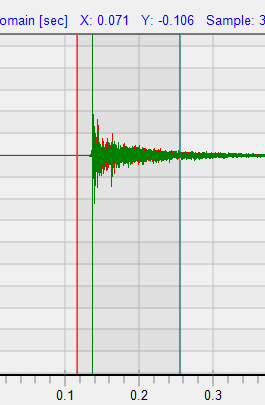
3. Left mouse-click into the chart left side of the pulse start, then right mouse-click about 0.2 seconds later

4. Select the magnifying button to zoom into the marked area
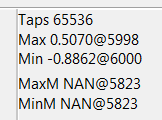
5. At the right side of the time chart the position of the maximum pulse value is displayed

6. Enter the position of the max. pulse value into the edit field below the time chart, confirm by Enter key
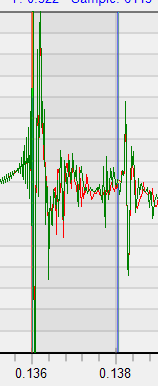
7. Right-click on a peak further to the right in the Time window.

8. On the right side of the time window, you can see the distance the sound traveled in addition until it arrived at the listening position.
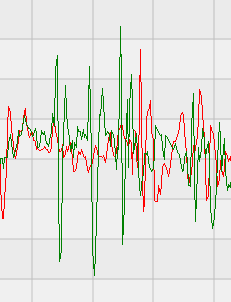
Reflexionen welche nur aus dem linken oder rechten Kanal eintreffen wirken sich besonders negativ aus, weil sie die notwendige Symmetrie zum Funktionieren des Stereo-Systems stören.
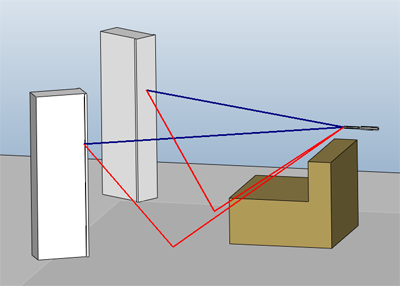
9. Hat man die Strecke ausgemessen, welche der Schall zusätzlich benötigt kann der Verursacher folgendermaßen ermittelt werden: Man spannt eine Schnur vom Hochtöner des Lautsprechers zum Hörplatz, verlängert die Schnur um die angegebene Strecke und ermittelt welche Flächen sich mit der Schnur berühren lassen: Die Blaue Linie ist der Weg des Direktschalls vom Lautsprecher zum Messmikrofon. Die rote Linie ist der längere Weg des Diffusschalls. Statt einer Schnur ist die Verwendung eines Laser-Entfernungsmessers hilfreich. So können auch leichter Reflexionspunkte von der Decke des Hörraums ausgemessen werden.
